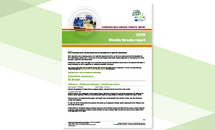ECDC Communicable disease threats report, Week 31, 27 July-2 August 2014
The ECDC communicable disease threats report is a weekly bulletin intended for epidemiologists and health professionals in the area of communicable disease prevention and control. Summarising information gathered by ECDC through its epidemic intelligence activities regarding communicable disease threats of concern to the European Union, it also provides updates on the global situation and changes in the epidemiology of communicable diseases with potential to affect Europe, including diseases that are the focus of eradication efforts.
Executive Summary
The ECDC Communicable Disease Threats Report (CDTR) is a weekly bulletin intended for epidemiologists and health professionals in the area of communicable disease prevention and control. This issue covers the period from 27 July to 2 August 2014 and includes updates on:
West Nile virus, transmission season in Europe
No new human cases of West Nile fever were reported in the EU. However, new cases were identified in EU neighbouring countries: Russia reported six cases and Serbia two new cases (one confirmed and one probable). West Nile fever in humans is a notifiable disease in the EU.
Outbreak of Ebola Virus Disease (EVD) in West Africa
Since the last CDTR, the affected countries reported 230 new cases and 69 new fatalities. On 29 July, WHO was notified of a probable EVD case in Nigeria. On 20 July, the case had travelled by air to Lagos via Lomé, Togo, and Accra, Ghana, and had been symptomatic at the time of arrival.
The EVD outbreak has been affecting Guinea, Liberia and Sierra Leone since December 2013. While this is the largest EVD outbreak ever reported, the risk of infection for travellers is considered very low.
ECDC published a risk assessment on 9 June and an epidemiological update on 17 July.
Middle East respiratory syndrome-coronavirus (MERS-CoV)
One new fatal case has been reported by Saudi Arabia in a previously reported case.
Since the beginning of the outbreak in April 2012, 853 cases of MERS-CoV infection have been reported by local health authorities worldwide, including 331 deaths.
ECDC published its updated rapid risk assessment on MERS-CoV on 31 May 2014 and an epidemiological update on 5 June 2014.
Chikungunya in the Caribbean
Compared to last week, the number of reported cases of chikungunya infections has risen by 7.4% in the affected areas. Barbados and Panama recorded their first autochthonous cases.
An outbreak of chikungunya virus infection has been ongoing in the Caribbean since December 2013, and has spread to North, Central and South America. There have been more than 470 000 probable and confirmed cases in the region, including 26 fatalities.
Download






